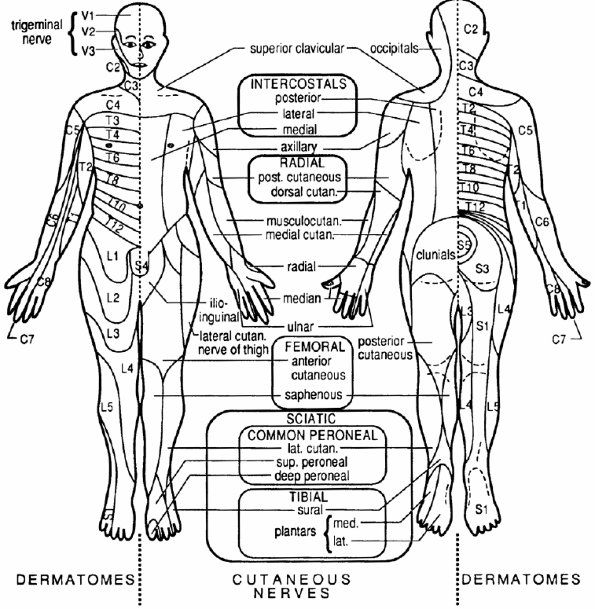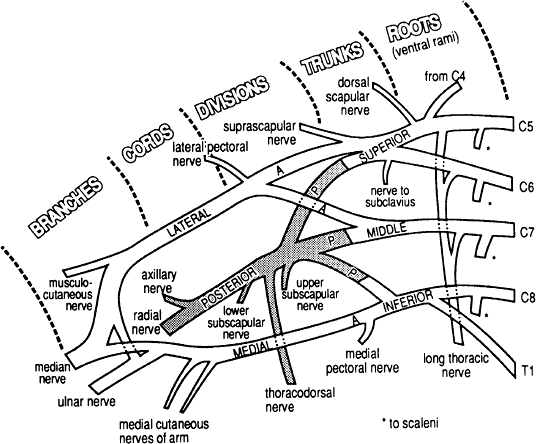Peripheral Nerve Anatomy
Authors: Flaherty, Alice W.; Rost, Natalia S.
Title: Massachusetts General Hospital Handbook of Neurology, The, 2nd Edition
Copyright 2007 Lippincott Williams & Wilkins
> Table of Contents > Adult Neurology > Peripheral Nerve Anatomy
Peripheral Nerve Anatomy
A. See also
Peripheral Neuropathy p. 93.
B. Spinal level by disc
Table 23. Symptoms of disc herniation. | ||||||||||||||||||||||||||||||||||||||||
|---|---|---|---|---|---|---|---|---|---|---|---|---|---|---|---|---|---|---|---|---|---|---|---|---|---|---|---|---|---|---|---|---|---|---|---|---|---|---|---|---|
| ||||||||||||||||||||||||||||||||||||||||
 |
Figure 10. Dermatomes and peripheral nerve territories. (From Patton HD, et al. Introduction to Basic Neurology. Philadelphia: Saunders; 1976, with permission.) |
P.90
C. Spinal level by function
1. Movement:
a. Neck: C1-4.
b. Diaphragm: C3-5.
c. Shoulder: Abduction and lateral rotation are C5. Adduction and medial rotation are C6-8.
d. Elbow: Flexion is C5-6. Extension is C6-8.
e. Wrist: C6-8. Extension = radial n. Flexion = median + ulnar n.
f. Hand: Finger abduction and adduction are ulnar nerve (C8-T1). Grip is median nerve. Finger extension is radial nerve.
g. Thumb test: Can tell radial, median, and ulnar nerve lesions by thumb movements. Mnemonic is RUM: Radial extends, Ulnar adducts, and Median abducts. Flexion + extension = in plane of the palm; abduction + adduction = at right angles to the palm.
h. Intercostals: T2-9.
i. Abdominals: Upper is T9-10. Lower is T11-12.
j. Hip: Flexion is L2-4, adduction is L3-4, abduction is L5-S1.
k. Knee: Extension is L2-4; flexion is L4-S1.
l. Foot: Dorsiflexion is L4-S1; plantar flexion is S1-2.
m. Bladder, anal sphincter: S2-4.
2. Sensation:
a. Arm: Shoulders: C4; inner forearm: C6; outer forearm: T1; thumb: C6; fifth finger: C8.
b. Leg: Front of thigh: L2; medial calf: L4; lateral calf: L5; fifth toe: S1; midline buttocks: S3.
D. Spinal level by nerve
1. See also: p. 95 for sx of common entrapment syndromes.

Figure 11. The brachial plexus. (From Warwick R, Williams P. Gray's Anatomy. 35th ed. London: Churchill Livingstone; 1973, with permission.)
2. Brachial plexus: C5-T1.
a. Plexi:
1) Upper plexus: C5-6. Deltoids, biceps, supra- + infraspinatus.
2) Middle plexus: C7.
3) Lower plexus: C8-T1.
b. Cords: Upper-mid-lower plexi recombine to form three cords; lateral and medial cord then recombine to form median nerve.
1) Lateral cord (from upper + middle plexus) forms musculocutaneous nerve, lateral anterior thoracic nerve, median nerve.
2) Posterior cord (from upper, middle, and lower plexus) forms radial nerve, axillary nerve, and subscapular nerve.
3) Medial cord (from lower plexus) forms ulnar nerve, medial cutaneous nerve, median nerve.
3. Nerves of arm: Note that any weakness of both flexors and extensors or of all intrinsic hand muscles implies that the lesion cannot be a mononeuropathy.
a. Long thoracic nerve: C5-7. Serratus anterior. Test: scapula wings when pt presses arm forward against a wall.
b. Axillary nerve: C5-6. Deltoid, etc. Test: abduct arm >90 degrees.
c. Musculocutaneous nerve: C5-6. Biceps.
d. Radial nerve: C5-8, esp. C7. Extensors (triceps, wrist, and finger), supinator, brachioradialis.
e. Median nerve: C6-T1. Flexors except ulnar: most forearm flexors, flex. dig. superior; all pronators. Hand: LOAF muscles (Lumbricals 1 and 2, Opp. pollicis, Abd. poll. brev., Flex. poll. brev.).
f. Ulnar nerve: C8-T1. Flexor digitorum profundus 3 and 4, flexor carpi ulnaris. Most of intrinsic hand (except LOAF muscles above): thumb adductors and flexors, interossei, lumbricals 3 and 4, hypothenar muscles.
4. Leg:
a. Femoral nerve: L2-4.
1) Function: Extend knee.
2) Muscles: Iliopsoas, quadriceps, sartorius, rectus femoris.
b. Obturator nerve: L2-4.
1) Function: Adduct leg.
2) Muscles: Adductor longus, brevis, and magnus; gracilis, pectineus .
c. Sciatic nerve (tibial and peroneal nerve): L4-S2.
1) Function: Extend and abduct hip, flex knee, all foot mvts.
a) Deep peroneal nerve: Extends toes and ankle.
b) Superficial peroneal nerve: Everts foot.
c) Tibial nerve: Superficial tibial flexes foot; deep tibial flexes toes.
2) Muscles: Semitendinosus and semimembranosus, biceps femoris, gastrocnemius, soleus, foot muscles .
P.91
E. Spinal level by reflex
1. Cervical: Biceps is C5-6. Supinator is C5-6. Triceps is C6-8.
2. Thoracic: Scratch towards navel. Contraction with scratching above navel is T8-10; below navel is T10-12.
3. Lumbar: Knee is L2-4. Ankle is S1-2. Babinski is L4-S2.
EAN: 2147483647
Pages: 109